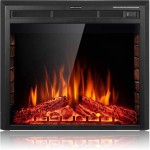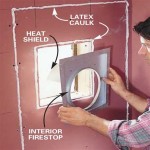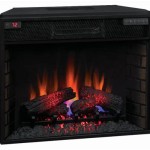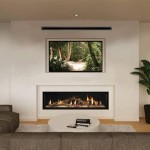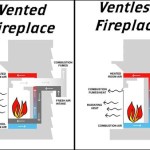Understanding Ventless Propane Fireplaces
Ventless propane fireplaces offer a convenient and potentially cost-effective heating solution for homes. They are designed to operate without a traditional chimney or venting system, making them easier to install in existing structures. However, their operation and safety considerations require careful understanding and adherence to manufacturer guidelines and local regulations.
The appeal of ventless propane fireplaces lies primarily in their installation simplicity and claimed energy efficiency. Because they don't require venting to the outside, they can be placed almost anywhere in a home, provided there's a propane gas line available or easily installed. This eliminates the significant construction costs associated with building or modifying a chimney. Furthermore, ventless fireplaces boast high heating efficiency ratings, as virtually all the heat produced stays within the room, unlike vented systems where a significant portion of the heat escapes through the chimney.
Despite these advantages, the operation and use of ventless propane fireplaces are subject to ongoing debate. Concerns revolve primarily around indoor air quality and the potential for carbon monoxide (CO) buildup. Therefore, a thorough examination of their functionality, safety features, and proper usage is crucial before considering their installation.
How Ventless Propane Fireplaces Work
Ventless propane fireplaces operate by burning propane gas within a closed combustion chamber. The key to their safe operation lies in the design of the burner and the precision of the air-to-fuel ratio. These fireplaces are engineered to achieve nearly complete combustion of the propane, minimizing the production of harmful byproducts like carbon monoxide. They typically utilize an Oxygen Depletion Sensor (ODS) to monitor the oxygen levels in the room. If the oxygen level drops below a pre-determined threshold, indicating potential carbon monoxide buildup, the ODS shuts off the gas supply, extinguishing the fireplace.
The combustion process in a ventless propane fireplace produces primarily water vapor, carbon dioxide, and heat. While carbon dioxide is naturally present in the air, excessive levels can become detrimental. The water vapor adds humidity to the room, which may be beneficial in dry climates but can be problematic in areas with high humidity, potentially contributing to mold growth. The amount of heat produced is regulated by the fireplace's BTU (British Thermal Unit) rating, which indicates the amount of energy it can generate per hour. Choosing the appropriate BTU rating for the room size is essential to prevent overheating and ensure comfortable heating.
The burner design is a critical component of a ventless propane fireplace. It is typically a ceramic or steel burner with precisely calibrated ports that ensure a consistent and even flame. Some models incorporate advanced burner technologies, such as infrared burners, to further enhance combustion efficiency and reduce emissions. Regular cleaning and maintenance of the burner are necessary to prevent clogging and ensure optimal performance.
Safety Considerations and Air Quality
The primary concern surrounding ventless propane fireplaces is their impact on indoor air quality and the potential for carbon monoxide poisoning. While these fireplaces are equipped with ODS sensors, their effectiveness relies on proper functioning and maintenance. Malfunctioning ODS sensors can lead to dangerous carbon monoxide accumulation. It's crucial to test the ODS regularly according to the manufacturer's instructions and replace it if necessary.
In addition to carbon monoxide, ventless propane fireplaces also produce other combustion byproducts, including nitrogen dioxide (NO2) and particulate matter. These pollutants can irritate the respiratory system and exacerbate pre-existing conditions like asthma. Adequate ventilation is essential to minimize the buildup of these pollutants. The manufacturer's instructions typically specify the minimum room size and ventilation requirements for safe operation. These requirements should be strictly adhered to.
Local building codes often regulate the use of ventless propane fireplaces, particularly concerning their BTU rating and installation requirements. Some jurisdictions may prohibit their use altogether due to safety concerns. It is imperative to check with local building authorities and obtain any necessary permits before installing a ventless propane fireplace. Failure to comply with local regulations can result in fines and potential safety hazards.
Furthermore, it is highly recommended to install a carbon monoxide detector in the same room as the ventless propane fireplace. A carbon monoxide detector provides an additional layer of protection by alerting occupants to the presence of dangerous carbon monoxide levels, even if the ODS malfunctions. Regularly testing the carbon monoxide detector and replacing its batteries are crucial for its proper functionality.
The presence of certain chemicals in the air, such as chlorine-based cleaners or solvents, can interfere with the proper functioning of the ODS. Avoid using these chemicals near the fireplace to prevent potential ODS malfunction and carbon monoxide buildup. Similarly, pet dander and dust can accumulate on the burner and affect combustion efficiency. Regular cleaning of the fireplace and surrounding area is essential to maintain optimal performance and prevent the release of harmful pollutants.
Proper Installation, Usage, and Maintenance
Proper installation is paramount for the safe and efficient operation of a ventless propane fireplace. It is strongly recommended that a qualified professional install the fireplace, ensuring that it is properly connected to the propane gas line and that all safety features are functioning correctly. The installation should adhere to the manufacturer’s specifications and local building codes.
Before using the fireplace for the first time, carefully read and understand the manufacturer's instructions. Pay close attention to the recommended room size, ventilation requirements, and safety precautions. Never operate the fireplace in a confined space or without adequate ventilation. Ensure that the ODS sensor is properly calibrated and functioning before each use.
Regular maintenance is essential to ensure the longevity and safe operation of a ventless propane fireplace. The burner should be cleaned regularly to remove dust, debris, and soot buildup. The ODS sensor should be tested periodically according to the manufacturer's instructions. The gas line connections should be inspected for leaks using a soap and water solution. Any leaks should be repaired immediately by a qualified professional.
Avoid placing combustible materials, such as curtains, furniture, or paper, near the fireplace. Maintain a safe distance between the fireplace and any flammable objects. Never use the fireplace to dry clothes or other items. Supervise children and pets closely when the fireplace is in operation. Educate children about the potential dangers of the fireplace and ensure that they understand the importance of not touching or tampering with it.
If the fireplace emits an unusual odor, produces excessive soot, or malfunctions in any way, immediately turn it off and contact a qualified service technician. Do not attempt to repair the fireplace yourself unless you are a qualified professional. Operating a malfunctioning fireplace can be extremely dangerous and can lead to carbon monoxide poisoning or a fire.
The use of ventless propane fireplaces requires a responsible approach. By understanding their operation, adhering to safety guidelines, and performing regular maintenance, homeowners can minimize the risks associated with their use and enjoy the warmth and ambiance they provide. However, it is crucial to continuously monitor indoor air quality and remain vigilant for any signs of carbon monoxide poisoning. The information provided here is for informational purposes only and should not be considered a substitute for professional advice. Consultation with qualified professionals and adherence to local regulations are essential for the safe and responsible use of ventless propane fireplaces.

Radiance Vent Free Gas Stove The Place
:max_bytes(150000):strip_icc()/ventless-gas-fireplaces-4160746-hero-f9d4bdcd9bd446eb84406de306f790ba.jpg?strip=all)
How To Pick Out A Ventless Gas Fireplace

Ventless Gas Fireplace Propane

The Debate Continues Are Ventless Fireplaces Safe

50 Free Standing Ventless Gas Fireplace Visualhunt

Vent Free Inserts White Mountain Hearth

Considering A Ventless Gas Fireplace Here S What You Need To Know Bob Vila

Vermont Castings Star Vent Free Gas Stove Inseason Fireplaces Stoves Grills Rochester Ny

Vent Free White Mountain Hearth

Bluegrass Living 38 5 In Black Ventless Liquid Propane Gas Fireplace The Fireplaces Department At Com
Related Posts

